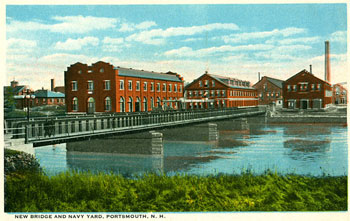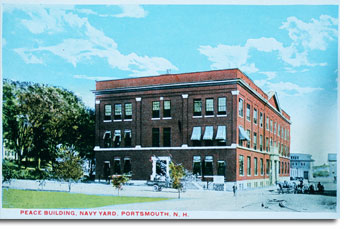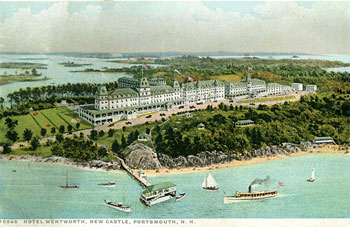
Place, Part Four: Portsmouth Navy Yard and Hotel Wentworth

Portsmouth Naval Shipyard. Richard Candee collection. View larger image.
 The Portsmouth Peace Treaty negotiations were held in the General Stores Building, now called Building 86, at the Portsmouth Naval Shipyard. Portsmouth Athenaeum collection. View larger image.
The Portsmouth Peace Treaty negotiations were held in the General Stores Building, now called Building 86, at the Portsmouth Naval Shipyard. Portsmouth Athenaeum collection. View larger image.Portsmouth Navy Yard
Established in 1800, Portsmouth is the nation's oldest government shipyard. Several of America's most famous sailing war ships were constructed here and in World War II Portsmouth contributed 75 submarines to the war effort. In recent years the yard's prime activity has been to refuel and overhaul nuclear submarines. In 1905, however, the yard was in one of it periodic declines, and, Roosevelt believed, a quiet place to hold a peace conference.
An event of this magnitude required a careful attention to diplomatic protocol. America's navy and marines, more than the other branches of the military, had a long record of international contacts, so the officers, enlisted men, and civilians were charged with maintaining the decorum and ceremony required, and expected, by Japan and Russia.
On July 10, the Portsmouth Herald announced that the negotiations would be held at the yard, and commander William Mead, who was promoted to rear admiral, was charged on short notice with making the navy yard ready for the peace conference. Concerned about security, Admiral Mead requested a detail of marines, and he announced that the yard would be closed to both the public and the press. Additional telegraph lines were installed for the delegates and Secretary Peirce, who had to keep Roosevelt informed. Four small vessels, called cutters and recently built at Portsmouth, were fitted out to provide transportation as needed between the yard and the Hotel Wentworth.
Mead requested the marine detachment not only for security but also as part of the protocol arrangements for the distinguished visitors. A simple yet dignified welcoming ceremony was planned and included officers and enlisted men in dress uniforms and the firing of cannons.
Finally, the new general stores building was made ready for the negotiations. A large room was set up for the conference discussions, while small, private anterooms were provided for each delegation. Ordered from Washington, the furniture was made of mahogany in the style of the cabinet room in the White House. Oriental rugs completed the décor. On the day the treaty was signed, the furniture was sold to yard officials and local people. Although the current whereabouts of most of this furniture is unknown, several pieces are now in the Portsmouth area, while the large conference table is in the Museum Meiji-Mura in Inuyama City, Aich Prefecture, Japan.

Hotel Wentworth was ideally located to house the peace envoys. Richard Candee collection. View larger image.
Hotel Wentworth
If the New Hampshire seacoast has an architectural grand lady, it is the Hotel Wentworth, originally built in 1874, then greatly expanded into a major resort by local "robber baron" Frank Jones. Situated in New Castle on the shore of Little Harbor where New Hampshire's first settlers arrived, the hotel offered proximity to the navy yard by vehicle or boat. Although Jones, who had been an ale tycoon, railroad president, and a congressman, had died, his will authorized his heirs to operate the hotel as he would have if alive. Jones' trustee Calvin Page agreed to provide the hotel's facilities for the conferees. With room for 500 guests, the Wentworth could accommodate not only the delegates, but also its usual summer guests. Although the major negotiations were held at the navy yard, the hotel was also the site of important informal negotioations and it was at the hotel where the armistice was signed. At the Wentworth Americans mixed with Russians and Japanese creating a relaxed atmosphere that contributed to the spirit of negotiation.
